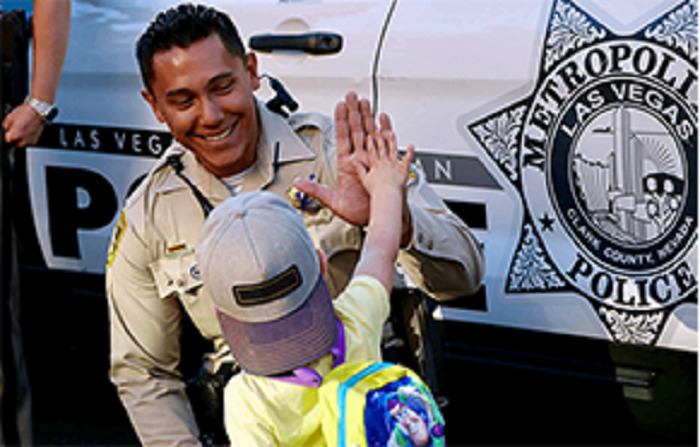
Those are the words written about the Ohio Going Blue site receiving feel-good stories depicting infinite positive interactions between police officers and citizens. Although the campaign is relatively new, the robust experiences enjoyed by cops and civilians has been around since forever (just under-reported by hyperbolic media platforms gluttoned with garbage and prejudiced against police).
Given the onslaught of haters’ broad brushes painting cops in a way which defies logic, the flood of positivity and truth and Americana is a delightful elixir to soothe souls. In a way, this is symbolic of my prior piece titled “Cops and the Silent Majority,” depicting several among myriad examples in which police-supporting citizens testify truth by doing good deeds for cops.
Here, we are glimpsing authentic nuggets directly from the people, as seen in police patrols safeguarding the American public in organic fashion. Let’s get the goodies going…
“Euclid Police Department (Ohio). While clearing a call, a group of kids at recess flagged me down to see my lights & hear my siren. I got out with them and handed out junior police stickers. Some of them said they want to be a police officer.”
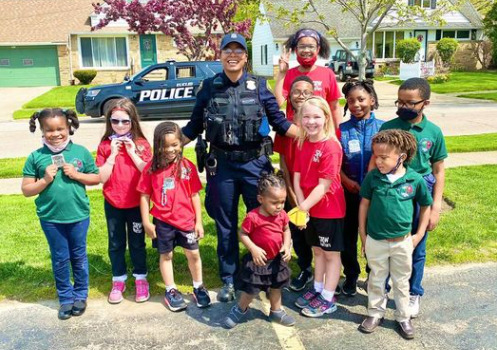
(South Euclid police officer among admiring children. Photo courtesy of Ohio Going Blue.)
As many know, cops ordinarily get their spark to be a police officer at an early age, usually from the presence of a uniformed law enforcement officer unwittingly providing a first impression. It is how I ignited my aspiration to be a cop, at around age 5-6, in the presence of NYPD’s Finest walking the beat.
Given our present climate in America, and the ongoing online false allegations against police personnel, it is these grassroots, organic interactions which beautifully counter the incendiary spread of naysayers stuck on hate born of persistent lies pushed by media outlets cradling their bottom line, truth be damned.
One of the things I marvel at is how many police programs exist on behalf of the citizenry, far more than when I worked a police beat. Nowadays, cop shops employ a handsome array of programs and equipment used by undeniably able police officials to mitigate and/or educate pretty much needing attention.
One example which maintains positive growth and public relations principles is the Coffee with a Cop initiative which is rooted all across the country. Together over cups of joe and baked treats, cops and citizens sit and chat about whatever comes up. Ordinarily, the communities problems are bandied about, with law enforcers taking notes as well as offering co-opted strategies to remedy whatever is deemed essential for enhanced quality of life. Think Broken Windows Theory, whereby police officers address the small issues before they burgeon into gargantuan woes.
Although that brand of enforcement may be easier said than down in some metropolis jurisdictions nowadays —Portland, NYC, LA, Chicago, to name a few— beat cops are mindful and try to not forfeit the basics, despite anti-cop crowds chanting how they do not want proactive police focused on preservation.
Nevertheless, police stories engendering great cops performing duties encompassing humane attributes are prevalent. For example, the following episode was reported by a passerby who observed an enraged man sitting outside a Starbucks. Police were notified and arrived, and this is what it looked like:
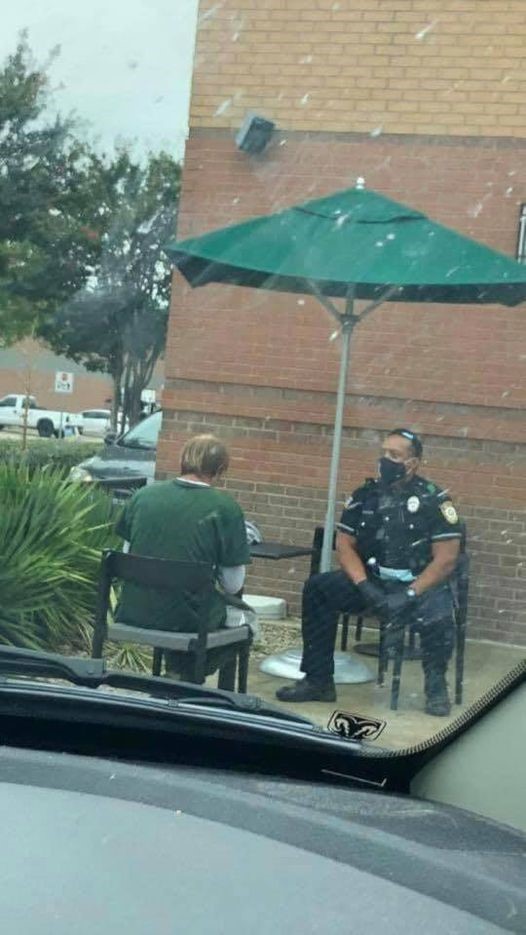
(Photo courtesy of Tracker Ray.)
That man who seemed to be experiencing a mental vent was treated with respect and decency by a policeman employing de-escalation skills; although such strategies do not always work, in this case it did and culminated in the citizen receiving help from the listening ears of a street cop, as observed by a citizen who reported the interaction:
“An officer appeared. He calmly and quietly approached the gentleman. He pulled up a chair and sat across from him and calmly asked the upset man what was going on. The officer, eye to eye, down on the troubled man’s level, de-escalated the situation quickly. I was moved to tears at how the officer respected this man and made it clear that he was there to help him. These are the stories that should be in the news.” Hear, hear!
With that encounter in mind, such an experience can go sideways fast…real fast. With mental health components often culminating in grotesque episodes for police officers trying to mitigate a person’s dire straits, the unknown is paramount and burgeons stress factors, exacerbating already-present vats of pressure.
Contemporarily, law enforcement agencies are starting to employ therapy dogs among their ranks; the objective is for these unconditionally loving animals to settle and soothe souls of stressed-out police professionals while on duty. Although my duty-related pressure-cookers were defused by working out in the police department gym, I wish we had a canine back then.
Recently, I watched “To Be of Service” on Netflix. The documentary covers a handful of military veterans who returned home embattled with PTSD, anxiety, depression, and a feeling they no longer fit in to society. My thoughts were how soldiers and cops have much in common, especially for cops nowadays; although on different battle fields, both roles see human depravity and/or are ostracized by some in society, sadly culminating in utterly dark thoughts.
The film concentrated on former soldiers finding some solace by acquiring and bonding with a trained service dog. According to studies and anecdotal revelations, many suffering from duty-related experiences eventually rid themselves of prescriptions, supplanting pills with canine partners. We are realizing the value of dogs in the law enforcement demographic as well, positively impacting both sworn and non-sworn personnel.
Although not fashioned for traditional crime-fighting, sniffing out concealed narcotics, and sleuthing of hiding fugitives and/or missing persons, police therapy dogs are self-explanatory. The University of South Florida Police Department recently added “Bailey” to their ranks, the department’s first-ever therapy dog partnering the calming cop with Officer Marchesano.

(Photo courtesy of the University of South Florida Police Department.)
Bailey and Officer Marchesano patrol the massive campus in Tampa and meet/greet students and faculty engaging in studies which easily produces stress, so police therapy dogs are a win-win for the PD and the community it serves.
A USFPD post iterated: “Bailey is yet making her way around campus and spreading smiles in the process.” As mentioned at the beginning of this article, police departments are doing everything possible on behalf of their constituents, and this is one such piece of evidence.
As we near the end of April, Sexual Assault Awareness & Prevention Month is coming to a conclusion. Although we spoke of our military and municipal police forces experiencing related stress inducers and mitigations, we also see positive results when both nation-serving entities partner in proactive measures.
On Wednesday, the U.S. Coast Guard’s Sector St. Petersburg’s Victim Advocates joined forces with the Pinellas County Sheriff’s Office to host “Cover the Cruiser.” Attendees obtain blue magnetic ribbons, write the name of a victim near and dear to them, and cover the cruiser with them (seen below), symbolizing solidarity and support for victims of tragic sexual assaults.
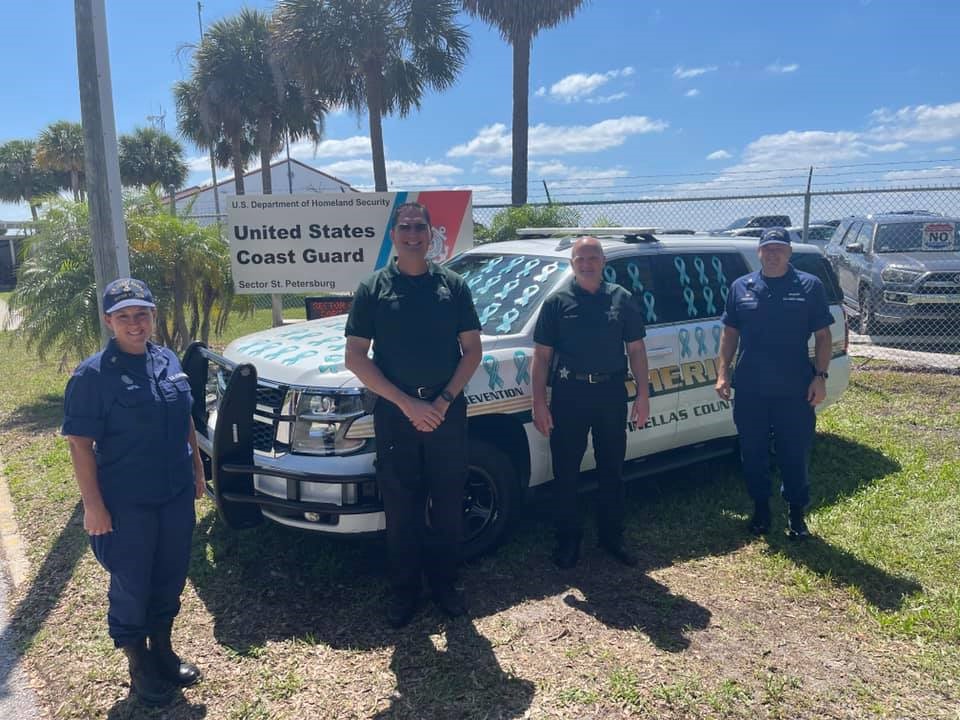
(Photo courtesy of the U.S. Coast Guard and Pinellas County Sheriff’s Office.)
Per a U.S. Coast Guard press release, “The event provides people with the opportunity to join in a community that pledges to believe survivors of sexual assault & support them. We cannot be reactive. We must be proactive!”
And what do you know: there was another super-soothing and smiling dog on scene to provide humans consolation from the thought of horrific crimes:
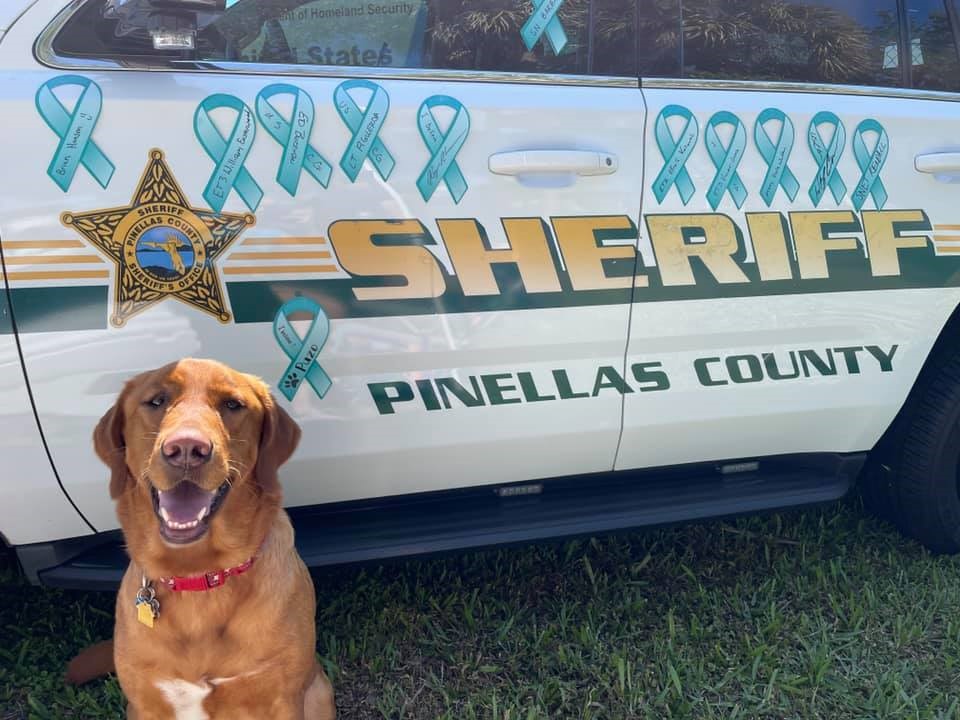
(Photo courtesy of the Pinellas County Sheriff’s Office.)
Whether in-person social-distanced gatherings involving cops and senior citizens highly vulnerable to scams and defrauders trying to take advantage of our elderly demographic, police officers do their darndest to safeguard against such economic depletion. Cops with the Coconut Creek Police Department make rounds and visit (tutor) the many senior citizen centers in their community:
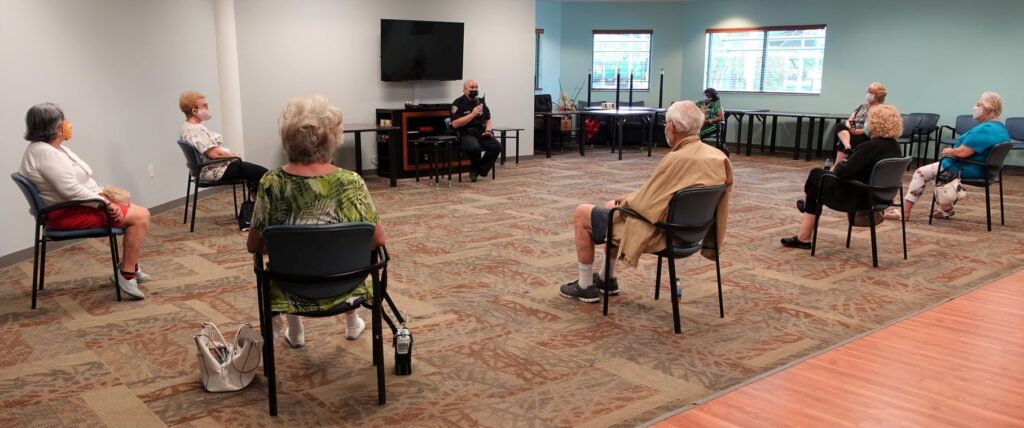
(Photo courtesy of the Coconut Creek Police Department.)
Economic crimes investigations are still difficult to conduct with any measure of success (arrest), since most are online extortions without easy identifications of suspects. Thus cops making the rounds to instruct on preventive measures is crucial to elders—to anyone.
Heck, there are tons of positive police news stories out there. So much so that the Department of Justice (DOJ) Office of Community Oriented Policing Services (COPS) chose to emphasize one particular agency for renowned law enforcement service provisions and stellar relations.
As the DOJ’s “Community Policing in Action” Photo Contest winner for April 2021, the Mission, Texas police department received kudos for exceptional police work, as explained in a DOJ press release:
“The MPD is committed to maintaining good will through community outreach and, to further this effort, the department holds various events through its Community Oriented Policing (COP) Unit. The winning photo shows MPD Officers Julio Perez and John Oliva partaking in the COP Unit’s 2019 Valentine’s Day visit to a Mission nursing home. During the visit, the officers chatted with residents of the nursing home and gave them flowers, with one resident asking MPD Corporal Robert Rodriguez if he would be her valentine.
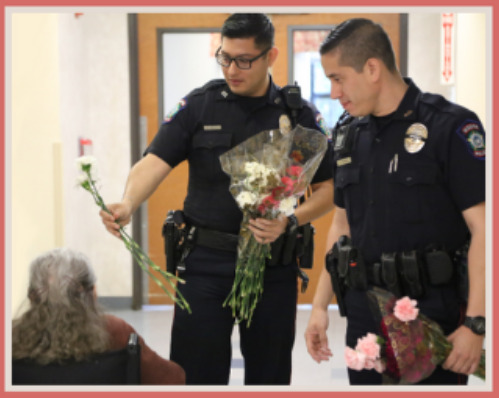
(Photo courtesy of the Mission Police Department.)
“Through its COP Unit, the MPD also hosts Thanksgiving dinners in November and, during the Christmas season, hosts a party for local families, each of whom receive a bag of toys carefully selected for the ages and genders of their children. When many Mission residents suffered from food shortages, the MPD held a barbecue and provided approximately 750 meals as a thank-you gesture for the community’s support of the department. The MPD also participates in Crime Stoppers, a public safety program that operates at the local level and provides a way for community members to anonymously tip off MPD officers to criminal activity. At the core of all of the MPD’s community activities is the philosophy of community policing, which emphasizes the importance of building relationships of mutual trust and cooperation.”
Mission PD definitely deserves accolades. As well, the numerous law enforcement entities conducting similar ventures in their respective jurisdictions are all worthy of honor.
There are infinite positive police stories circulating the globe, and this is just a small batch culled from many occurring in the United States, thanks to America’s brave, courageous police officers fighting the good fight as bona fide superheroes:
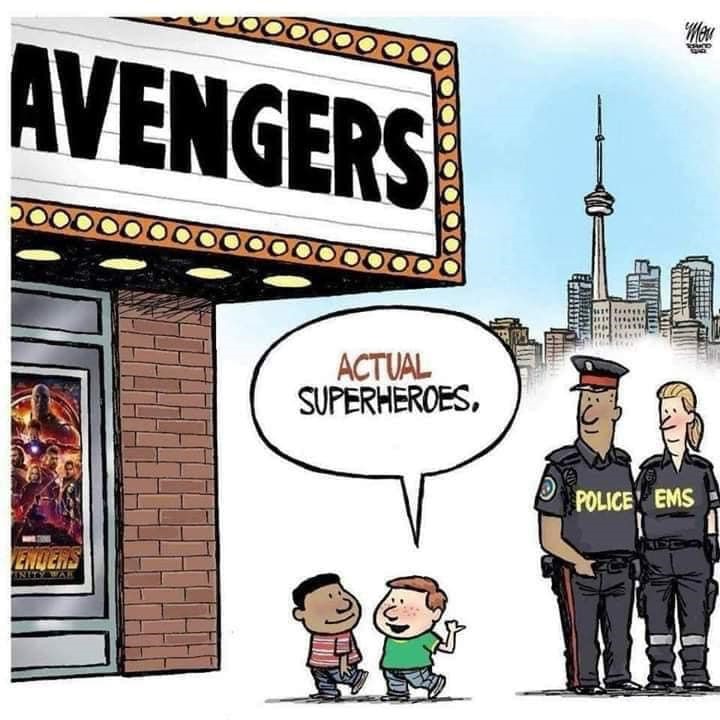
(Animation courtesy of Back the Blue.)
Despite the noise of some so-called adults echoing false claims about our nation’s law enforcement officers, at least kids know the truth and value of cops positively impacting our society. The high-fiving child in our cover photo involving a Las Vegas Metro police officer is an apropos illustration of our topic today…a picture attributing police relations and at least one thousand positive words.
As has always been the case and will forever remain as such: Cops are the good guys and gals providing new bicycles to kids, cleaning pools, trimming elders’ overgrown lawns, redirecting wayward juveniles, rounding up loose livestock, role-modeling students, tying kids’ laces, dispensing cool treats, offering out-of-pocket kindness, pushing stalled cars to safety, changing motorists’ flat tires, celebrating birthdays in COVID-era, eradicating graffiti, patronizing entrepreneurial kiddos, providing turkeys on holidays, educating turkeys about truth, safeguarding special events, clothing the homeless, enabling the disabled, supporting fallen cops’ kids, placing themselves in harm’s way, taking tons of heat from utopian-crazed critics, righting society’s wrongs, and returning day in and day out to deliver goodness on behalf of everyone.
Whew… What’s that saying about wearing many hats?
For further reading, the Community Policing Dispatch commissioned a survey entailing “250 police foundations in the U.S. & Canada to identify and publicize positive examples of community-police engagement,” the highlights of which are contained in the “The Positive Community-Police Engagement Report.”